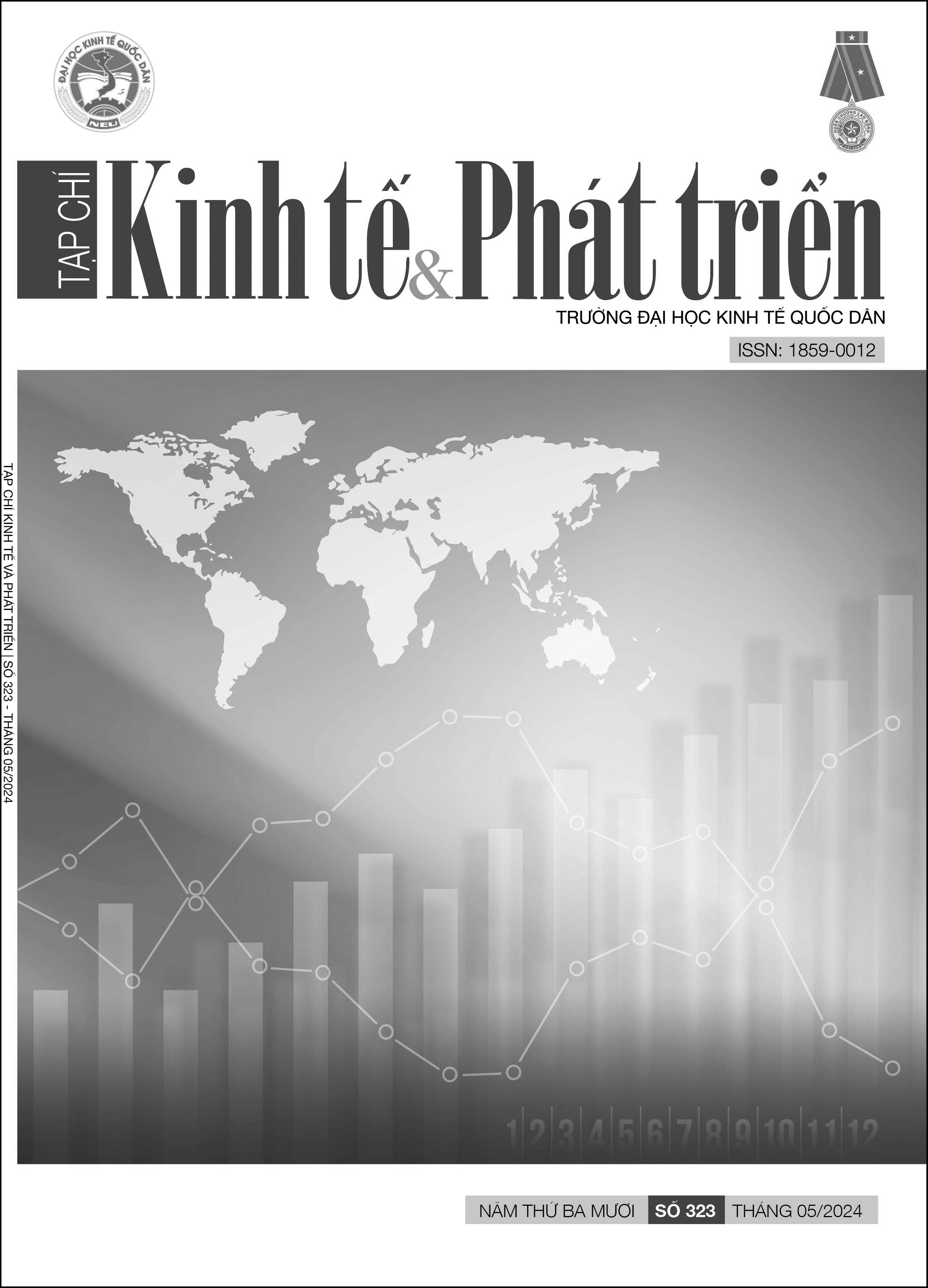Nghiên cứu sự phụ thuộc lợi nhuận của tiền kỹ thuật số: tiếp cận phương pháp Copula có điều kiện
DOI:
https://doi.org/10.33301/JED.VI.1553Từ khóa:
Tiền kỹ thuật số, Copula có điều kiện, phụ thuộc lợi nhuậnTóm tắt
Bài viết nghiên cứu sự phụ thuộc lợi nhuận của hai đồng tiền điện tử Bitcoin và Ethereum trong 3 giai đoạn: trước dịch COVID-19 từ đầu năm 2018 đến cuối năm 2019, giai đoạn trong COVID-19 từ đầu năm 2020 đến gần cuối năm 2021 và giai đoạn chiến tranh của Nga – Ukraine từ đầu năm 2022 đến đầu năm 2023. Nghiên cứu sử dụng chuỗi dữ liệu thời gian từ tháng 1 năm 2018 đến tháng 1 năm 2023, áp dụng phương pháp Copula có điều kiện để đo lường cấu trúc phụ thuộc của dữ liệu chuỗi thời gian. Kết quả nghiên cứu cho thấy có sự phụ thuộc mạnh của tỷ suất lợi nhuận của 02 đồng tiền kỹ thuật số trong giai đoạn nghiên cứu, từ kết quả này tác giả đề xuất các hàm ý cho nhà đầu tư cũng như hoạch định chính sách trong thời gian tới.
Tài liệu tham khảo
Bakar, N. A., & Rosbi, S. (2018), ‘Statistical Diagnostics for Bivariate Correlation and Regression Analysis between Cryptocurrency Exchange Rates of Bitcoin and Ethereum’, International Journal of Economics, Commerce and Management, 5(2018-4), 1-11.
Bianconi, M., Yoshino, J. A., & De Sousa, M. O. M. (2013), ‘BRIC and the US financial crisis: An empirical investigation of stock and bond markets’, Emerging Markets Review, 14, 76-109.
Boako, G., Tiwari, A. K., & Roubaud, D. (2019), ‘Vine copula-based dependence and portfolio value-at-risk analysis of the cryptocurrency market’, International Economics, 158, 77-90.
Bouri, E., Gupta, R., Lau, C. K. M., Roubaud, D., & Wang, S. (2018), ‘Bitcoin and global financial stress: A copula-based approach to dependence and causality in the quantiles’, The Quarterly Review of Economics and Finance, 69, 297-307.
Dungey, M., & Tambakis, D. (2005), Identifying international financial ontagion: progress and challenges, Oxford University Press.
Gupta, R., & Guidi, F. (2012), ‘Cointegration relationship and time varying comovements among Indian and Asian developed stock markets’, International Review of Financial Analysis, 21, 10-22.
Hanif, W., Hernandez, J. A., Troster, V., Kang, S. H., & Yoon, S. M. (2022), ‘Nonlinear dependence and spillovers between cryptocurrency and global/ regional equity markets’, Pacific-Basin Finance Journal, 74, 101822.
Horvath, R., & Petrovski, D. (2013), ‘International stock market integration: Central and South Eastern Europe compared’, Economic Systems, 37(1), 81-91.
Jeon, B. N., & Von Furstenberg, G. M. (1990), ‘Growing international co-movement in stock price indexes’, Quarterly Review of Economics and Business, 30(3), 15-31.
Jeribi, A., & Fakhfekh, M. (2021), ‘Portfolio management and dependence structure between cryptocurrencies and traditional assets: evidence from FIEGARCH-EVT-Copula’, Journal of Asset Management, 22(3), 224-239.
Jin, X., & An, X. (2016), ‘Global financial crisis and emerging stock market contagion: A volatility impulse response function approach’, Research in International Business and Finance, 36, 179-195.
Jondeau, E., & Rockinger, M. (2006), ‘The copula-garch model of conditional dependencies: An international stock market application’, Journal of international money and finance, 25(5), 827-853.
Kakinaka, S., & Umeno, K. (2022), ‘Asymmetric volatility dynamics in cryptocurrency markets on multi-time scales’, Research in International Business and Finance, 62, 101754.
Karanasos, M., Yfanti, S., & Karoglou, M. (2016), ‘Multivariate FIAPARCH modelling of financial markets with dynamic correlations in times of crisis’, International Review of Financial Analysis, 45, 332-349.
Kimani, E. M., Ngunyi, A., & Mungatu, J. K. (2023), ‘Modelling Dependence of Cryptocurrencies Using Copula Garch’, Journal of Mathematical Finance, 13(3), 321-338.
King, M. A., & Wadhwani, S. (1990), ‘Transmission of volatility between stock markets’, The Review of Financial Studies, 3(1), 5-33.
Luchtenberg, K. F., & Vu, Q. V. (2015), ‘The 2008 financial crisis: Stock market contagion and its determinants’, Research in International Business and Finance, 33, 178-203
Park, R. E., Elsner, C., & Elsner, H. (1972), ‘The Crowd and the Public, and Other Essays. Edited and with an Introduction by Henry Elsner, Jr.... Translated by Charlotte Elsner, Etc’, University of Chicago Press.
Patton, A. J. (2006), ‘Modelling asymmetric exchange rate dependence’, International Economic Review, 47, 527-56.
Pericoli, M., & Sbracia, M. (2003), ‘A primer on financial contagion’, Journal of economic surveys, 17(4), 571-608.
Rehman, M. U., Katsiampa, P., Zeitun, R., & Vo, X. V. (2023), ‘Conditional dependence structure and risk spillovers between bitcoin and fiat currencies’, Emerging Markets Review, 55, 100966.
Rigobon, R. (2002), ‘Contagion: how to measure it?’ In Preventing currency crises in emerging markets (pp. 269-334), University of Chicago Press.
Rockinger, M., & Jondeau, E. (2001), ‘Conditional Dependency of Financial Series: An Application of Copulas’, SSRN Electronic Journal, doi:10.2139/ssrn.1730198.
Rodriguez, J. C. (2007), ‘Measuring financial contagion: A copula approach’, Journal of empirical finance, 14(3), 401-423.
Santos, T. D. (1970), ‘The structure of dependence’, The american economic review, 60(2), 231-236.
Sklar, M. (1959), ‘Fonctions de repartition an dimensions et leurs marges’, Publ. inst. statist. univ. Paris, 8, 229-231.
Thuan, L. T. (2011), ‘The relationship between the United States and Vietnam stock markets’, International Journal of Business and Finance Research, 5(1), 77-89.
Vo, X. V., & Ellis, C. (2018), ‘International financial integration: Stock return linkages and volatility transmission between Vietnam and advanced countries’, Emerging Markets Review, 36, 19-27.
Wang, K. M. (2013), ‘Did Vietnam stock market avoid the “contagion risk” from China and the US?, The contagion effect test with dynamic correlation coefficients’, Quality & quantity, 47(4), 2143-2161.
Yang, L., Cai, X. J., Li, M., & Hamori, S. (2015), ‘Modeling dependence structures among international stock markets: Evidence from hierarchical Archimedean copulas’, Economic Modelling, 51, 308-314.
Zivot, E. & Wang, J. (2006), Modelling Financial Time Series with S- plus, Springer, New York.





